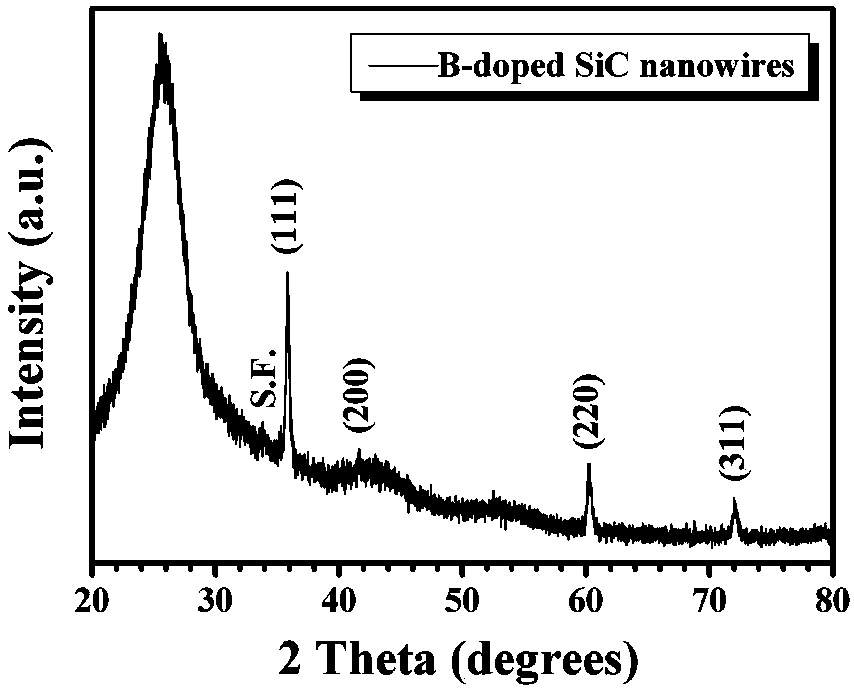Application of b-doped sic nanowires in field emission cathode materials
A field emission cathode and emission cathode technology, applied in the field of nanomaterials, can solve the problem of insufficient SiC flexible cathode system, and achieve the effects of good cost controllability, high electron emission stability, and convenient processing
- Summary
- Abstract
- Description
- Claims
- Application Information
AI Technical Summary
Problems solved by technology
Method used
Image
Examples
Embodiment 1
[0046] The initial raw material is selected from polysilazane, in N 2 Thermal cross-linking and curing was carried out under the protection of atmosphere at 260 °C for 30 min. The solid SiCN obtained by curing was put into a nylon resin ball mill, and milled into powder. Weigh 300mg polysilazane powder and 60mg B 2 O 3 Powder, mix the powder evenly and place it at the bottom of the graphite crucible. Cut carbon cloth 5×5cm (length×width), in 0.05mol / L Co(NO 3 ) 3 Immersion in ethanol solution and ultrasonic treatment for 10s, take out and place in air to dry naturally. The treated carbon cloth substrate was placed on the top of the graphite crucible, and then put into a graphite resistance-heated atmosphere sintering furnace together with the crucible. The atmosphere furnace is first evacuated to 10- 4 Pa, and then filled with high-purity argon (purity 99.99%) until the pressure was one atmosphere (~0.11Mpa), and the pressure was constant thereafter. Then, it was rapidly...
Embodiment 2
[0049] The B-doped SiC nanowires grown on carbon fiber cloth in Example 1 were used as flexible cathodes, and they were cut into five pieces of 0.4 × 0.6 cm 2 The five flexible cathodes were bent 0, 50, 100, 150 and 200 times respectively (the bending radius was 1.2 cm), and then the cathodes were placed in a planar structure into the field emission test system in turn, and the system was evacuated to 1.5×10 - 7 Pa, and finally the field emission performance of the flexible cathode was tested at room temperature. Image 6 Digital photographs of the flexible field emission cathodes used for testing, showing that the cathodes are highly flexible. Figure 7 is the field emission current density-electric field intensity curve of the flexible cathode after 0, 50, 100, 150 and 200 times of bending, indicating that the open electric field of the flexible cathode is 0.94, 0.93, 0.95, 0.91, 0.92 V after different bending times / μm, has a very low turn-on electric field, and remains ...
Embodiment 3
[0051] The B-doped SiC nanowires grown on carbon fiber cloth in Example 1 were used as flexible cathodes, and they were cut into five pieces of 0.4 × 0.6 cm 2 The five flexible cathodes were bent into concave I, concave II, planar, convex I and convex II structures (wherein, the bending radius of concave I and convex I was 1.2 cm, the concave II and convex II with a bending radius of 0.4cm), then the cathodes were sequentially loaded into the field emission test system, and the system was evacuated to 1.5×10 -7 Pa, and finally the field emission properties of the flexible cathodes with five structures were tested at room temperature. Figure 9 are the field emission current density-electric field intensity curves of the flexible cathode in five bending states, indicating that in different bending states, the open electric field of the flexible cathode is only 1.01, 0.98, 0.94, 0.89 and 0.86 V / μm, respectively, indicating that It has a very low turn-on electric field in differ...
PUM
 Login to View More
Login to View More Abstract
Description
Claims
Application Information
 Login to View More
Login to View More - R&D
- Intellectual Property
- Life Sciences
- Materials
- Tech Scout
- Unparalleled Data Quality
- Higher Quality Content
- 60% Fewer Hallucinations
Browse by: Latest US Patents, China's latest patents, Technical Efficacy Thesaurus, Application Domain, Technology Topic, Popular Technical Reports.
© 2025 PatSnap. All rights reserved.Legal|Privacy policy|Modern Slavery Act Transparency Statement|Sitemap|About US| Contact US: help@patsnap.com



